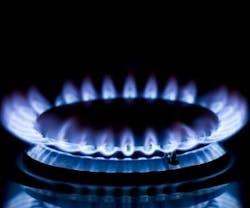Procuring Energy at Less Cost in Fluctuating Markets
As our economy rebounds, fuel prices will oscillate as the forces of supply and demand jockey for equilibrium. There may be relatively large price spikes and dips during this process.
This creates risks or opportunities for facility managers who buy lots of energy. Some facility managers have the ability to lock in prices with futures contracts or other offerings from the utility’s local distribution company. However, other facility managers may have to switch fuels if one commodity gets too high in price. Having the ability to switch can present a cost savings opportunity.
Point of Use Costs
The evaluation of which fuel is most economical is commonly called “point of use costing.” It incorporates not only the fuel cost, but also the efficiency of the technology consuming that fuel. For example, assume that I have an electric water heater that operates at 99% efficiency and my electric costs are $0.10 per kWh. If natural gas is also available at my facility, how cheap would natural gas need to be for me to deliver the same amount of energy via natural gas?
To solve the above problem, we need to evaluate the cost per unit of energy delivered. Let’s use MMBTU as the common unit.
For electricity, assume that our cost is $0.10/kWh, and that 1 kWh = 3413 BTU or (.003413 MMBTU), therefore our equation becomes:
= ( $0.10)/.003413 MMBTU
= $29.3/MMBTU
This calculation shows us the cost of the energy delivered, but we also want to know the fuel required and its cost, so we need to incorporate the efficiency of the technology via the following equation:
- Energy Input (fuel amount) x Efficiency = Energy Delivered
Eric A. Woodroof, Ph.D.
Eric A. Woodroof, Ph.D., is the Chairman of the Board for the Certified Carbon Reduction Manager (CRM) program and he has been a board member of the Certified Energy Manager (CEM) Program since 1999. His clients include government agencies, airports, utilities, cities, universities and foreign governments. Private clients include IBM, Pepsi, GM, Verizon, Hertz, Visteon, JP Morgan-Chase, and Lockheed Martin.
In the electric system, our efficiency is 99%, so to get the fuel cost, we must divide by the efficiency:
- $29.3/.99
- $29.6/MMBTU
If we switch to natural gas at 75% efficiency, our fuel costs would be:
For natural gas, assume our cost is $9/MMBTU. Since we already have the MMBTU units we want, all we need to do is incorporate the efficiency:
= ($9/MMBTU)/.75
= $12/MMBTU
Therefore, we could save almost $18 per MMBTU by switching to natural gas. We can use this savings estimate to evaluate the payback of the infrastructure changes necessary to enable a switch in fuels.
The above example is a simple application that you can use to optimize your fuel costs. However, be aware that if the prices change, your savings will too! You can control some of this variability by purchasing futures contracts or locking in a contract price with your utility. Of course, if you lock in a price that ultimately proves lower or higher than the market price, the situation may become a painful case or a windfall.
For example, a large university campus had the opportunity to lock in a price for natural gas in a contract that would ensure the university would be just under budget for the year. However, the purchasing manager delayed signing the contract, hoping that the price for natural gas would go down, but instead the price went higher and the university ended up being $2 million over budget. Needless to say, the purchasing manager then had to defend his decision, a situation that did not go well.
An Innovative Solution
Facilities managers can rely on a number of measures to mitigate energy costs, but a new idea that has caught my attention can work for large energy users as well as utilities that are buying different types of energy commodities. The idea is this: when gas is relatively inexpensive, use it to make electricity!
OK, that is not a new idea – except that this gas does not need to come from the grid. It can come from a landfill, bio-digester or other green source that may yield environmental benefits.
Another gas source is “stranded well-heads.” When natural gas prices drop below a certain level, it doesn’t make sense for a well owner to sell the gas to a utility because he won’t make a profit. The well becomes “stranded” when it generates no revenue. In this situation, it makes sense to take the cheap natural gas through a filter and a generator to make electricity, which can be sold into the grid. This approach can also allow utilities to place small electric generating units (distributed energy) at weak points of the grid to provide a cushion.
Many things need to be aligned for this technology to be cost-effective, but I like the idea of more distributed energy coming from natural gas, which has about a 40% emissions reduction compared to coal-based electricity generators. The contract can be written so that the user can get fixed kWh costs and thus avoid price spikes. The gas can come from a landfill or bio-digester, which could mean that the generator could earn and sell Renewable Energy Credits, which could improve the economics even further (and be attractive to a utility that must meet portfolio requirements). One example of a company that is transforming natural gas into electricity at the well is Well Head Energy Systems LLC (www.wellheadenergy.com).
There are many ways to buy energy less expensively or to use a cheaper fuel. As our economy fluctuates, fuel prices will too, and this means opportunity for those who jump on mitigating strategies. It is a good time to be in energy management!
RELATED STORIES
World Energy Engineering Congress: A Showcase of Innovation and Efficiency
